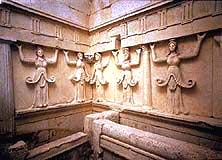 BULGARIA
BULGARIA 
The
Bulgarian lands are ancient crossroads. They remember many ancient civilizations
and great people which wrote the pages of their turbulent history: bronze and
iron spears and arrows, ruins of palaces and cities, wise words carved on rocks
and stone columns, written on parchment and leather. The Thracians bequeathed
us the famous tombs near Kazanluk and Sveshtari, the unique gold treasures from
Panagyurishte and Rogozen. The Hellenes built the beautiful coastal towns of
Apollonia, Anhialo and Messambria, and Romans - ancient Aescus, Nikopolis ad
Istrum and Nove. Huns, Gothes and Averas later pass through our lands. Around
the mid-7th century the Slavs came from the north across the Danube and reached
as far as the Black Sea and the Adriatic. They were followed by the Bulgarians
of Khan Asparouh. In fact, there were only three states in Europe in 681, when
Bulgaria was founded: The Western Roman Empire, BULGARIA, and The Eastern Roman
Empire (Byzantium). The UNESCO's List of World Heritage consists of over 300
landmarks as the planet's most valuable cultural and natural heritage sites.
Nine of these wonders are in Bulgaria: seven cultural and two natural sites.
1.
Kazanluk Tomb - Discovered in 1944, this tomb dates from the Hellenistic
period, around the end of the 4th century B.C. It comprises three rooms built
of brick. The dromos and funerary chambre are decorated with frescoes, representing
in particular a funeral banquet. The wall paintings by an unknown artist, mainly
in red, black, white and green, show a genuine talent, which is relatively free
of the Greek influence.
2.
Madara Horseman - Carved into the side of a cliff in the 8th century, this
knight triumphing over a lion commemorates the victories of the Bulgarian Khans
in an era when their power posed a serious threat to Byzantium. The inscriptions
beside the sculpture relate events that occurred between 705 A.D. and 831 A.D.
3.
Rock Churches near the village of Ivanovo - Ivanovo is a complex of churches,
chapels, monasteries and cells dug into rock near the medieval town of Tchervan
and the city of Veliko Tarnovo, the capital of the second Bulgarian state. Five
of the churches and chapels date back to the 13th and 14th centuries, and are
richly decorated with frescoes.
4.
The Thracian tomb near Sveshtari -Discovered in 1982, this 3rd-century B.C.
Thracian tomb inspired by Greek design has a unique architectural decor with
polychromed half- human, half-plant caryatids and painted murals. It is a remarkable
reminder of the culture of the Getes, Thracian populations in contact with the
Hellenistic and Hyperborean worlds, according to ancient geography.
5.
Boyana Church - Located in the outskirts of Sofia, Boyana Church is composed
of three buildings. The Eastern Church was built in the 10th and 11th centuries.
The middle - Kayolan - church contains two superimposed sanctuaries. It is covered
with frescoes, painted in 1259, making it one of the most important collections
of medieval paintings.
6.
The Ancient city of Nesebur - Situated on a rocky peninsula of the Black
Sea, the 3000-year-old site of Nessebar was originally a Thracian settlement
(Menebria). The city then became a Greek colony and one of the most important
strongholds of the Byzantine Empire. The city's monuments date mostly from the
Hellenistic period and include the acropolis, an Apollo temple and an agora.
Other important monuments are the basilica of Stara Mitropolia and wooden houses
built in the 19th-century Plovdiv style.
7.
Rila Monastery - The Convent of Rila, rebuilt between 1834 and 1860, incorporates
the legacies of Saint Ivan of Rilski, 10th-century evangelist of the Slavs,
and the remains of a medieval monastery into a distinctive neo- Byzantine monument.
Characteristic of the Bulgarian Renaissance, this monument symbolises the awareness
of a Slavic cultural identity following centuries of occupation.
8.
Pirin National Park - The park has a limestone Balkan landscape, with its
lakes, waterfalls, caves and pine forests, and a rich flora containing many
endemic plant species. The rugged mountains, with around seventy glacial lakes
scattered throughout them, are a relic of the ancient glacial days of Europe
9.
Sreburna Reserve - The Srebarna Nature Reserve is a fresh-water lake supplied
from the Danube, extending over 600 hectares. It is the breeding home of close
to 100 species of birds, many of which are rare or endangered. Some 80 other
bird species migrate and seek refuge there every winter.
 BULGARIA
BULGARIA 
 BULGARIA
BULGARIA 








